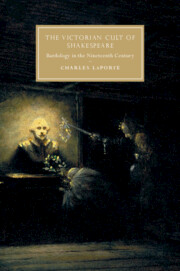Book contents
- The Victorian Cult of Shakespeare
- Cambridge Studies In Nineteenth-Century Literature And Culture
- The Victorian Cult of Shakespeare
- Copyright page
- Dedication
- Contents
- Figures
- Preface
- Acknowledgments
- Introduction
- Chapter 1 Shakespearean Sermons and Other Pious Texts
- Chapter 2 The Harmonies and Beauties of Devotional Shakespeare Volumes
- Chapter 3 The Sonnets and the Messiah
- Chapter 4 The Authority of the (Missing) Author
- Chapter 5 Shakespearean Clerisies and Perfect Texts
- Conclusion: Concealed Wonders and Choice Treasures
- Notes
- Selected Bibliography
- Index
- Cambridge Studies in Nineteenth-Century Literature and Culture
Chapter 2 - The Harmonies and Beauties of Devotional Shakespeare Volumes
Published online by Cambridge University Press: 30 October 2020
- The Victorian Cult of Shakespeare
- Cambridge Studies In Nineteenth-Century Literature And Culture
- The Victorian Cult of Shakespeare
- Copyright page
- Dedication
- Contents
- Figures
- Preface
- Acknowledgments
- Introduction
- Chapter 1 Shakespearean Sermons and Other Pious Texts
- Chapter 2 The Harmonies and Beauties of Devotional Shakespeare Volumes
- Chapter 3 The Sonnets and the Messiah
- Chapter 4 The Authority of the (Missing) Author
- Chapter 5 Shakespearean Clerisies and Perfect Texts
- Conclusion: Concealed Wonders and Choice Treasures
- Notes
- Selected Bibliography
- Index
- Cambridge Studies in Nineteenth-Century Literature and Culture
Summary
Chapter Two, “The Harmonies and Beauties of the Substitute Bible,” takes up mid-Victorian devotional guidebooks that reprint lines of Shakespeare alongside or in conjunction with parallel quotations from the Bible: works like Frederic B. Watson’s Religious and Moral Sentences Culled from the Works of Shakespeare, compared with Sacred Passages drawn from Holy Writ (1843), J. B. [“Selkirk”] Brown’s Bible Truths with Shakespearean Parallels (1862), James Rees’s Shakespeare and the Bible (1875), and G. Q. Colton’s Shakspeare and the Bible: Parallel Passages and Passages Suggested by the Bible with the Religious Sentiments of Shakspeare (1888). Such nineteenth-century texts offer signal evidence of how the Victorians read Shakespeare as a religious expression in his own right, and in such a manner that lines from the plays fall parallel to, or serve as equivalents for, lines of scripture.Many of these texts in their original context would seem to have nothing to do with religion, but here they become reframed as unexpected expressions of the divine.
- Type
- Chapter
- Information
- The Victorian Cult of ShakespeareBardology in the Nineteenth Century, pp. 50 - 79Publisher: Cambridge University PressPrint publication year: 2020

